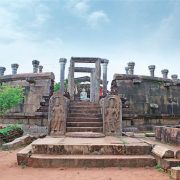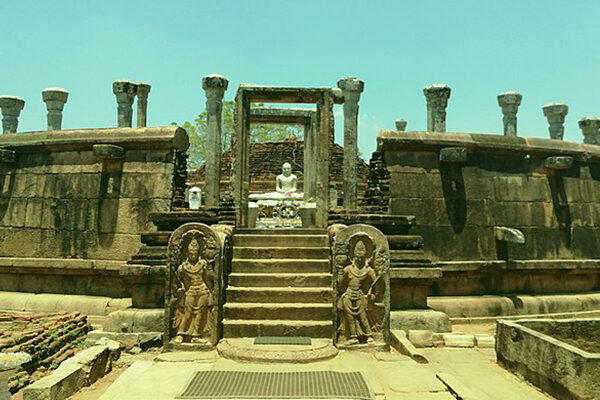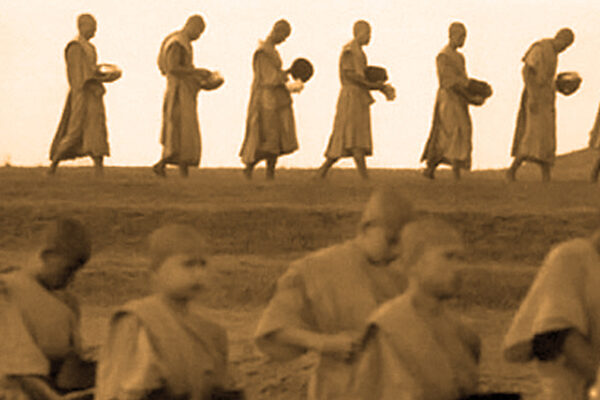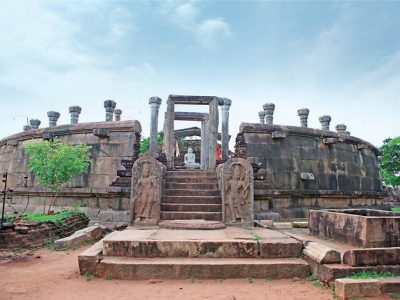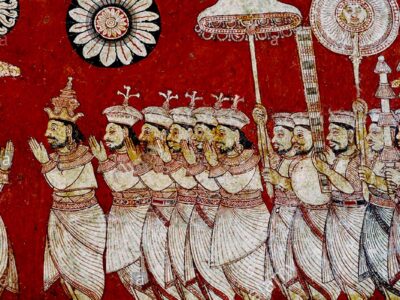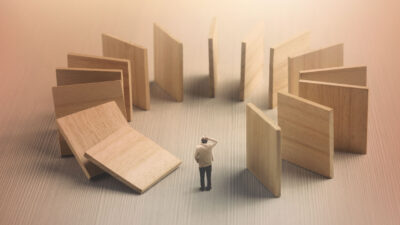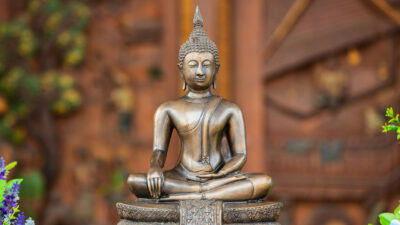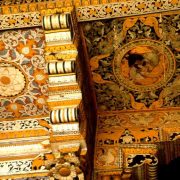The Pali Chronicles of Ceylon, earlier or later, contain innumerable references to shrines, Getiya is the most general name for any sanctuary which can well stand for thupa, arama, vihara and assembly hall, a tree, a memorial stone, a holy relic or object or place or even an image.
It may mean any shrine particularly associated with Buddhism. A Buddhist Vihara is a habitation for monks, a hut or lodging for a bhikkhu, a single room, a remote shelter for a bhikkhu, a place for convention of the monks, a meeting place, a place for rest and recreation, a building for housing the monks etc.
An Arama means a garden or a wooded enclosure a surrounding a vihara or a temple. An attempt has been made here to give an account of some of the important ancient shrines of Ceylon as far as can be gathered from the Chronicles of Ceylon written in Pali.
Abhayagiri
Abhayagiri vihara, also known as the Abhaya vihara, was a famous religious building on the north side of Anuradhapura, built by King Vattagamini Abhaya, on the site of the ancient Tittharama, after the foundation of the Maha vihara. This vihara became rapidly prosperous. A temple and a pavilion were built in it. Gajabahukagamani raised the height of the thupa in the Abyahagirivihara and made a tank to be used for the cultivation of the land belonging to it.
For a long time the fraternities of the Maha Vihara and the Abhayagirivihara lived in amity. The rivalry between them was at first a personal matter, but it afterwards confined itself to their doctrinal difference. In this vihara there was a stone image of the Buddha held peculiarly sacred. At the foot of the Bo-tree standing here there was a stone platform together with a beautiful wall according to the Culavamsa.
Thuparama
The Thuparama was a monastery in Anuradhapura, which was bell-shaped and enclosed by a colonnade formed of roughhewn and Palmyra palm shaped pillars of stone supporting the roof. The art of the Thuparama colonnade continued until the 12th century A.C. and may be maintained at Madirigiriya and Vatadage (Polonnaruwa) as rightly pointed out by Dr. Barua.
It was erected by Devanampiyatissa and was the first of its kind in Ceylon. It was situated in the southern direction according to the Dipavamsa. It was built after the thupa was erected.
To its east Lajjitissa built the Dighathupa in which he constructed receptacles cased in stone. Between this monastery and the Mahameghavanarama an Uposatha hall was constructed. In this monastery Amandagamani (surname Abhaya) built a double canopy made of silver over the thupa.
The cetiya of Thuparama was situated near the southern wall of the city in the Nandana garden which stretched between Mahameghavana, where now the Mahavihara stands, and the southern wall of the city of Anuradhapura. A relic chamber was built in the Thuparama, where King Vasabha ordered one thousand oil lamps to be lit.
When the beautiful thupa in the Thuparama was completed, it was worshipped perpetually with many gifts of jewels. Lajjitissa leveled the ground between the Thuparama and the Mahathupa. A village was granted to the Thuparama for its maintenance.
Dighavapi
It was at the Dighavapi cetiya that the Buddha, who was compassionate to the whole world, came down from the sky and entered upon the mystical meditation. Rising up from the trance the Master proceeded to the Mahameghavanarama, where the Bo-tree was planted. Saddhatissa founded the Dighavapi Vihara. It was nine leagues from Tissamaharama. This cetiya was built at the spot where the Buddha sat in meditation.
Mahameghavanarama
The Mahameghavanarama, which stretched south of the capital city of Anuradhapura, was accepted by Mahinda for the construction of a monastery therein for the monks. This garden was turned into a monastery called the Tissarama.
The Mahameghavana was the first arama which was bestowed on the Fraternity. This was the first monastery in the island of Lanka. Bhatutissa put up a wall-fence with towers at the gates of the Mahameghavanarama. A golden thupa was built in this arama. Here King Samghabodhi ordered for the distribution of rice milk continually.
This arama was once known as the Mahasagara which was given to the Buddha as a precious gift. During the time of the Buddha Kakusandha this garden was also known as the Mahatittha, which was also presented to the Buddha as a precious gift. The Bodhi-branch was planted there. Mahinda went to this grove and stayed there. According to the Mahavamsa, this arama was visited by the Buddha. It was situated to the south of Anuradhapura. King Devanampiyatissa presented it to the monks as a monastery.
Lohapasada
Lohapasada was originally built up Devanampiyatissa in Anuradhapura forming the uposatha hall of the Mahavihara. It was pulled down and re-built by Dutthagamani. It was exceedingly costly quadrangular palace of nine stories in height built at the expense of thirty crores.
The beautiful Lohapasada was roofed with iron plates by Saddhatissa. It was four sided, measuring on each side too cubits and so much in height. In this pasada there were nine stories and in each storey there were one hundred window chambers. All the chambers were decorated with silver and their coral balustrade were adorned with precious stones. There were one thousand well-arranged chambers in it.
Surrounded by a beautiful enclosure and provided with four gateways it stood as a magnificent palace. As it was covered with bricks of copper and iron it came to be known as the Brazen Palace. It was presented to the Brotherhood. The order gathered together at the presentation ceremony.
On the first storey stood the ordinary people, on the second storey those versed in the three pitakas and on each of the three upper storeys, beginning with the third, the Stream-Winners, the Once-Returners, and the Non-Returners respectively, but the Canker waned alone stood on the four uppermost storeys.
According to the Mahavansa, Saddhatissa added new seven stories to this palace. Gothabhaya renewed the pillars of this palace, Dutthagamani raised aloft to seven storeys the Lohapasada built by Devanampiyatissa. Many pasadas were built round the Lohapasada. Bhatikabhaya carried out repairs to the Brazen Palace. He described the contents of the relic chamber of the Mahathupa to all the monks of the Mahavihara assembled in the Lohapasada.
Mahathupa
Mahathupa was built by Dutthagamani in Anuradhapura. When Devanampiyatissa was informed by Mahinda of the great sanctity of the place, he wished to build the tupa himself. But Mahinda asked him not to do so; it would be done by Dutthagamani. The thupa was like water–bubble in shape and its architect was Sirivaddha. The Cetiya was 120 cubits high. The relic chamber was magnificent. It is a great place of pilgrimage of the Buddhists from the time of its erection down to the present day. It is known by some other names e.g. Mahacetiya, Hemavaluka.
Mahathupa was visited by the Buddha, where the Master together with the pupils attained mystical trance. He spent in meditation on the site of the Mahathupa according to the Dathavamsa. It was a gigantic bell-shaped relic shrine built at Anuradhapura about 160 years B.C. King Dutthagamani erected it on the model of the Sanchi and Bharhut stupas, at the foundation of which the following materials were used; Chunam work, great stones, clay, bricks, pure earth, a plate of iron, small gravels, eight layers of stones, twelve layers of crystal and silver.
After the foundation was laid the monks were summoned, and the circle of the base of the cetiya was described. When the foundation of the Mahathupa was laid, many theras were present some of them came from Jambudipa. The King Dutthagamani spent twenty or twenty-four in valuable treasures for building the Mahathupa.
Around this great Thupa a wall was built decorated with figures of elephants and also a beautiful enclosure. Abhaya, the son of Kutikanna, paid a visit to the monks in this beautiful Mahathupa. He walked round it and saw the Relic chamber. He ordered a priceless network of coral to be made covering the surface of the Mahathupa. He made strong pillars for placing lamps around the foot of the Thupa. He ordered the lights to be lit seven times. He caused a tube to be laid around the foot of the Thupa and to be filled with oil. He ordered the oil lamps to be lit fourteen times.
A channel was dug to the west of the Thupa in order to make a water offering. He caused flowers to be planted around the Thupa, and a flower thicket. Sirinaga and Tissaka each erected a parasol over the Mahathupa. Asangatissa also fixed a golden parasol over it.
According to the Mahavansa, many labourers were employed to build it. There was a relic chamber, and in its midst a Bodhi-tree made of jewels was placed. Saddhatissa completed the work on the parasol, the plaster work and the elephant work on the Great Thupa.
The Mahathupa with its lofty height and imposing mound bears testimony to the splendid architecture of Ceylon. It really stands as an architectural landmark. Other dagabas around it are similar to it as regards the ground plan, appearance and technique of art.
The Mahathupa class of Buddhist stupas in Ceylon later came to be provided with four entrance-points, each containing an image inside, reminding us of the famous Shwe Dagon Pagoda of Burma. The Mahatupa represents a purely Ceylon architecture as regards its inner inspiration, main conception and method of execution, to which our attention has already been drawn by Dr. Barua.
Mahavihara
Mahavihara was a great monastery in Anuradhapura and a great centre of Buddhism in Ceylon for many centuries. It was founded by Devanampiyatissa at the request of Mahinda and it included the Mahameghavanarama. It had many buildings attached to it, apart from the scared shrines. Dhatusena had the walls of the Mahavihara painted with various ornamental designs.
Mahavihara lost its importance after the removal of the capital from Anuradhapura to Pulatthipura. In the Mahavihara, Tissa built twelve edifices. King Samghabodhi constructed a room in it, where food was distributed by tickets. Abhaya (surname Meghavanna) built a stone pavilion in the Mahavihara. Gothabhaya also built a stone pavilion in it, and Meghavannabhaya constructed several parivenas in this great vihara. The Mahavihara was built in the Nandana garden.
Mahiyangana
The Mahiyangana Thupa was situated in the Mahanaga garden, three vojanas long and one vojana wide, Sarabhu, a pupil of the Elder Sariputta received from the funeral pile the collar bone relic of the Master and laid it in this shrine. Uddhaculabhaya made it 30 cubits high, according to the Mahavansa and the Thuypavansa. Dutthagamani Abhaya came here and subdued the Damilas.
Parasols were put in the Mahiyanganavihara, as in the Abhayagiri vihara and Maricavati Vihara. According to the Dathavamsa a thupa called Kancuka was built. According to the Culavamsa it was venerated by celebrating a great festival with many fragrant flowers, lamps etc.
Mirisaveti
The Maricavattivihara was completed in three years of Dutthagamani (101-77 BC). King Dutthagamani assembled the order to hold a festival in honour of the monastery. Many monks and nuns gathered together. In that assembly the King bowed down before the Order and spoke this’ “Revered Sirs, through forgetfulness I ate a pepper- pod without giving it to the Order. I have built the Maricavatti monastery as an act of expiation. May the Order accept the monastery together with the shrine!”
When the monastery was given to the Order, he built around the monastery a great sitting hall for the monks. The pillars of the hall were set in the water of the Abhaya tank. The monastery was renovated by Voharikatissa. Gothabhaya built an uposatha hall there. A village was granted to the vihara for its maintenance. Parakramabahu I re-built the thupa destroyed by the Damilas.
A monastery was built on the Cetiyapabbata which later on came to be known as the Missaka Mountain. It was the place where Mahinda spent the last years of his life and died. Devanampiyatissa built a vihara there. Four grates and a road round the mountain were made by Mahadathikamahanga. Many lamps were provided by Vasabha on the Ceitiyagiri. At the time of Rakusandha it was known as Devakuta. The ruined buildings of the Cetiyagiri were restored by Aggabodhi V. Parakramabahu I re-built all the old buildings which were destroyed and set up many thupas.
Tisamaharama
Tissamahavihara or Tissarama was built by Tissa in Rohana, which was a place of pilgrimage of the Buddhists.
Dakkhinagiri
Dakkhinagirivihara was built by Uttiya. It was visited by Mahinda. It was a great monastic centre for a long time. A village was granted by Kassapa V for its maintenance and later Dhatusena restored it.
Bhuwanekabahu-parivena
This religious building was erected by Bhuvanekabahu who was the younger brother of Parakramabahu II. The founder was cremated there. A three-storied building was built with a Buddha image.
Kelaniya Temple
Kalyanicetiya was built on the spot where the Buddha preached to Maniakkhika and his follower. It enshrined the throne on which the Buddha sat. A parasol was erected on it by Voharikatissa. There was a monastery attached to the Cetiya. An uposatha hall was built there. This monastery was restored by Vijayabahu III. It was damaged by the Damilas and the Cetiya was reconstructed.
Jetavanaramaya
Jetavana-vihara was situated near the Abhayagiri Dagaba in Anuradhapura.
(Kind courtesy from “The Ceylon Daily News Vesak Annual”)
By – Dr. B. C. Law (D. Litt, Ph.D. M.A.)


